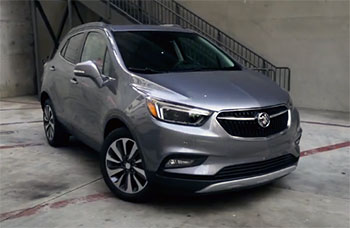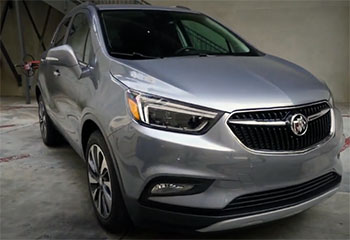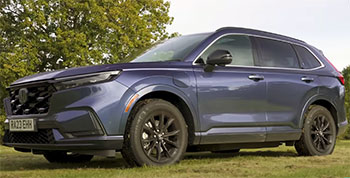I’ve been on the hunt for a compact SUV that fits my life—something practical, comfortable, and affordable without feeling like I’m driving a boring box on wheels. The Buick Encore and Honda CR-V kept popping up in my research, so I decided to take a close look at both.
My goal? To help you figure out which one suits your needs by comparing their features, performance, and value. This article breaks down my experience with these vehicles, weighing their pros and cons to guide you toward the right choice.
Comparison Table: Buick Encore vs. Honda CR-V
| Feature | Buick Encore (2022) | Honda CR-V (2024) |
|---|---|---|
| Starting MSRP | $26,100 | $29,500 |
| Fuel Economy (City/Highway) | 24/32 MPG | 28/34 MPG |
| Engine | 1.4L Turbo 4-cylinder (155 hp) | 1.5L Turbo 4-cylinder (190 hp) |
| Cargo Space (Seats Up/Down) | 18.8/48.4 cu. ft. | 39.3/75.8 cu. ft. |
| Front Legroom | 40.82 in | 41.3 in |
| Second-Row Legroom | 35.75 in | 41.0 in |
| Infotainment Screen | 7-inch touchscreen | 5-inch or 7-inch touchscreen (higher trims) |
| Standard Safety Features | Rearview camera, OnStar® | Honda Sensing (adaptive cruise, lane keep assist) |
| Warranty | 4yr/50,000 miles | 3yr/36,000 miles |
| Reliability Rating (iSeeCars) | 7.2/10 | 9.0/10 |
My First Impressions
Walking into a dealership to check out the Buick Encore and Honda CR-V, I wasn’t sure what to expect. The Encore caught my eye with its sleek, compact design—almost like a luxury crossover trying to blend into the city crowd. The CR-V, on the other hand, felt more substantial, like it was ready to tackle a family road trip without breaking a sweat.
Both SUVs have their charm, but they cater to slightly different vibes. Let me walk you through what I found, from the driver’s seat to the cargo space, and share what makes each one tick.
Exterior Design: Style Meets Practicality

The Buick Encore’s exterior is understated but classy. Its compact size—168.35 inches long—makes it a breeze to maneuver through tight city streets or squeeze into a packed parking lot.
The front grille, with its chrome accents, gives it a touch of sophistication, like it’s dressing up for a night out.
I appreciated how it doesn’t scream for attention but still looks polished. However, if you’re after a bolder presence, the Encore might feel a bit too subtle.
The Honda CR-V, at 182.1 inches long, has a more commanding stance. Its angular headlights and sculpted lines give it a rugged, ready-for-anything look. It’s the kind of SUV that says, “I can handle your weekend camping trip.”
But that larger size can make it trickier to navigate in urban settings. I found myself wondering if I’d struggle to parallel park it in my neighborhood.
Pros of Buick Encore Exterior:
- Compact size for easy parking and city driving
- Sleek, upscale design with chrome accents
- Aerodynamic shape reduces wind noise
Cons of Buick Encore Exterior:
- Less imposing presence compared to larger SUVs
- Limited color options on some trims
Pros of Honda CR-V Exterior:
- Bold, rugged design appeals to adventure seekers
- LED headlights standard on most trims
- Larger size offers a more substantial road presence
Cons of Honda CR-V Exterior:
- Bigger footprint can be cumbersome in tight spaces
- Base model’s design feels less premium
Also Read: Comparison of Buick Encore And Nissan Rogue.
Interior Comfort: Where You’ll Spend Your Time

Sliding into the Buick Encore, I was pleasantly surprised by its upscale interior.
The seats are plush, with high-quality materials that feel like they belong in a pricier vehicle.
The QuietTuning™ technology, with triple door seals and acoustic laminated glass, made the cabin feel like a sanctuary, even when I was stuck in traffic.
But the back seat? It’s a bit cramped. With only 35.75 inches of second-row legroom, taller passengers might feel squeezed on longer drives.
The Honda CR-V’s interior, by contrast, feels like a spacious living room. With 41 inches of second-row legroom, it’s a haven for passengers, especially families. The materials are solid but not as luxurious as the Encore’s—think practical over posh.
I loved how airy the cabin felt, thanks to the larger windows, but the base model’s 5-inch infotainment screen looked dated compared to the Encore’s 7-inch display.
Pros of Buick Encore Interior:
- Premium materials and upscale feel
- Quiet cabin thanks to QuietTuning™ technology
- Comfortable front seats for long drives
Cons of Buick Encore Interior:
- Limited rear legroom for taller passengers
- Smaller cargo space (18.8 cu. ft. with seats up)
Pros of Honda CR-V Interior:
- Spacious rear seating for families
- Larger cargo area (39.3 cu. ft. with seats up)
- Intuitive layout with plenty of storage
Cons of Honda CR-V Interior:
- Base model’s infotainment screen feels small
- Materials less luxurious than Encore’s
Performance: Power and Efficiency on the Road

Under the hood, the Buick Encore’s 1.4L turbo 4-cylinder engine delivers 155 horsepower.
It’s peppy enough for city driving, but I noticed it struggled a bit on highway merges.
The 6-speed automatic transmission shifts smoothly, and the compact size makes it nimble.
Fuel economy is decent at 24 MPG city and 32 MPG highway, but I wished for a bit more power when I needed to pass slower traffic.
The Honda CR-V’s 1.5L turbo 4-cylinder engine, pumping out 190 horsepower, feels more confident. It accelerates with ease, whether you’re zipping through town or cruising on the interstate.
The continuously variable transmission (CVT) is smooth but can feel less engaging. With 28 MPG city and 34 MPG highway, it edges out the Encore in efficiency, which I appreciated when calculating gas costs for my daily commute.
Pros of Buick Encore Performance:
- Nimble handling for urban environments
- Smooth transmission shifts
- Adequate power for daily driving
Cons of Buick Encore Performance:
- Underpowered for highway passing
- Slightly lower fuel economy than CR-V
Pros of Honda CR-V Performance:
- Stronger engine for better acceleration
- Superior fuel economy
- Confident handling with AWD options
Cons of Honda CR-V Performance:
- CVT can feel less responsive
- Larger size impacts agility in tight spaces
Read More: My Thoughts On Acura MDX Vs. Volvo XC90
Technology: Staying Connected on the Go
The Buick Encore’s tech suite impressed me with its standard 7-inch touchscreen, Apple CarPlay, and Android Auto. The interface is user-friendly, and the 6-speaker audio system delivers crisp sound for my playlists. OnStar® integration adds peace of mind with features like stolen vehicle tracking and emergency assistance, which Honda doesn’t offer. However, the lack of advanced driver aids on the base model was a letdown.
The Honda CR-V steps up with the Honda Sensing suite, standard on all trims. Adaptive cruise control, lane-keeping assist, and automatic emergency braking made me feel safer on the road. The base model’s 5-inch screen felt like a throwback, but higher trims offer a 7-inch display with similar smartphone integration. The CR-V’s 4-speaker audio system was adequate, but I missed the richer sound of the Encore’s setup.
Pros of Buick Encore Technology:
- Standard 7-inch touchscreen
- OnStar® adds unique safety features
- Better standard audio system
Cons of Buick Encore Technology:
- Limited advanced safety features on base trim
- Fewer standard tech upgrades compared to CR-V
Pros of Honda CR-V Technology:
- Honda Sensing safety suite standard
- Intuitive infotainment on higher trims
- Wireless connectivity on select models
Cons of Honda CR-V Technology:
- Base model’s 5-inch screen feels outdated
- Audio system less impressive than Encore’s
Safety: Keeping You and Your Passengers Protected
Safety is a big deal for me, and both SUVs deliver solid credentials. The Buick Encore boasts a 5-star NHTSA rating, with features like a rearview camera and optional front/rear park assist. The QuietTuning™ technology also reduces road noise, helping me stay focused. However, advanced safety features like lane departure warnings are only available on higher trims, which bumped up the price more than I expected.
The Honda CR-V also earns a 5-star NHTSA rating, but its standard Honda Sensing suite gives it an edge. I felt confident with features like collision mitigation braking and road departure mitigation, especially on long drives. The CR-V’s larger size also means better crash test scores for neck and chest compression, which added to my peace of mind.
Pros of Buick Encore Safety:
- 5-star NHTSA safety rating
- Quiet cabin enhances driver focus
- Optional park assist is a unique feature
Cons of Buick Encore Safety:
- Advanced safety features not standard
- Slightly lower crash test scores than CR-V
Pros of Honda CR-V Safety:
- Honda Sensing suite standard on all trims
- Excellent crash test performance
- Larger size adds structural safety
Cons of Honda CR-V Safety:
- Base model lacks some premium safety options
- Noisy engine can be distracting
Reliability and Ownership Costs
Reliability matters when you’re investing in a vehicle. According to iSeeCars, the Honda CR-V scores a 9.0/10 for reliability, significantly higher than the Buick Encore’s 7.2/10. Consumer Reports also ranks Honda seven places higher than Buick for overall brand reliability. This made me lean toward the CR-V for long-term dependability, especially since I plan to keep my SUV for years.
Ownership costs tell a different story. The Encore’s starting MSRP of $26,100 is notably lower than the CR-V’s $29,500. Buick’s 4-year/50,000-mile warranty also outshines Honda’s 3-year/36,000-mile coverage, giving me confidence in fewer out-of-pocket repairs early on. However, the CR-V’s better resale value (retaining 68.9% of its value after five years compared to the Encore’s 56%) could save you money when it’s time to sell.
Pros of Buick Encore Ownership:
- Lower starting price
- Longer warranty coverage
- More Buick dealerships for service
Cons of Buick Encore Ownership:
- Lower reliability rating
- Poorer resale value
Pros of Honda CR-V Ownership:
- Higher reliability rating
- Better resale value
- Included maintenance for 1 year/12,000 miles
Cons of Honda CR-V Ownership:
- Higher starting price
- Shorter warranty period
Driving Experience: City Streets to Open Highways
Test-driving the Buick Encore was a joy in the city. Its compact size and tight turning radius made weaving through traffic feel effortless. The suspension soaked up bumps well, and the quiet cabin kept me calm during rush hour. On the highway, though, the engine felt underpowered, especially when I needed to overtake. It’s a great urban companion but less thrilling for long-distance drives.
The Honda CR-V, with its larger footprint, felt more planted on the highway. Its 190-horsepower engine handled merges with ease, and the independent suspension provided a smooth ride. In the city, however, I had to be more mindful of its size when parking or navigating narrow streets. The CR-V’s versatility makes it a better all-rounder, but it’s less agile than the Encore in tight spots.
Cargo and Utility: Packing for Life’s Adventures
Cargo space is where the Honda CR-V shines. With 39.3 cubic feet behind the rear seats and 75.8 cubic feet with them folded, I could easily fit camping gear, groceries, or even a small piece of furniture. The low load floor and wide tailgate made loading a breeze. The Buick Encore, with 18.8 cubic feet behind the seats and 48.4 cubic feet max, felt more limited. I could manage daily errands, but bigger hauls were a challenge.
Both SUVs offer seating for five, but the CR-V’s extra legroom makes it better for families. The Encore’s under-seat storage was a nice touch for small items, but it couldn’t compete with the CR-V’s cavernous cargo area.
Which One Fits Your Lifestyle?
After spending time with both, I realized the Buick Encore is perfect if you’re a city dweller like me, prioritizing affordability, maneuverability, and a touch of luxury. Its lower price and premium interior make it a great value, but the cramped rear and lower reliability scores might give you pause if you need a family hauler or plan to keep it long-term.
The Honda CR-V, meanwhile, is the go-to for versatility. Its spacious interior, strong reliability, and advanced safety features make it ideal for families or anyone who values long-term dependability over initial cost. The trade-off is a higher price and less agility in urban settings.
Read More: My Thoughts On Acura MDX Vs. Lexus GX
Frequently Asked Questions (FAQ)
The Buick Envision is the most comparable to the Honda CR-V, offering similar size, cargo space, and family-friendly features, though it’s pricier and more luxurious.
Honda is more reliable, with the CR-V scoring 9.0/10 on iSeeCars compared to the Buick Encore’s 7.2/10. Consumer Reports also ranks Honda higher overall.
The Buick Encore is moderately reliable, with a 7.2/10 rating from iSeeCars. It’s solid for a compact SUV but trails behind the Honda CR-V.
The Honda HR-V is a close match to the Buick Encore, with a similar compact size, urban-friendly handling, and competitive pricing, though it offers less luxury.
My Final Thoughts
You’re probably wondering which SUV I’d pick. Honestly, it depends on what you need. If you’re navigating city streets and want a stylish, budget-friendly ride, the Buick Encore’s compact size and upscale vibe are hard to beat. But if you’re planning family road trips or want a vehicle that’ll hold its value and last for years, the Honda CR-V’s reliability and space make it a no-brainer. Test-drive both, think about your daily drives, and you’ll find the one that feels like home.

